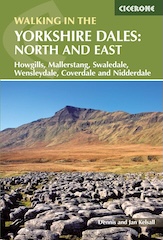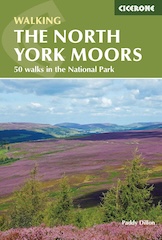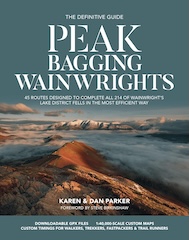Experience a Family-Friendly Trek on the Dent Walk in the Yorkshire Dales
Begin your Dent walk at the Dentdale pay-and-display car park, conveniently located in the centre of Dent village. The car park, situated on Laning opposite Dent Primary School, offers ample parking space. Once parked, cross the road and head south down Dragon Croft. As you walk, you’ll pass the rear yard of the Sun Inn on your left. Continue along Dragon Croft until you reach the bottom, where you’ll spot Flintergill House on your right.
Shortly after passing Flintergill House, you’ll enter the enchanting woods of the Flinter Gill ravine. Follow the woodland trail as it winds upwards through the valley, tracing the course of Flinter Gill. This path is well-trodden and easy to navigate. After a steady ascent of just over half a mile, you’ll leave the woods behind and step into open countryside. The path remains clear and well-defined as you continue for another quarter of a mile.

At this point, you’ll reach a junction where the path intersects with Green Lane (Track). Turn left here and follow Green Lane, which will lead you in a south-east direction. Enjoy the gentle walk along this track for approximately 1¼ miles until you arrive at the junction with Nun House Outrake. The route is straightforward, and the views across Dentdale are a highlight of this section of your Dent walk.
Next, turn left onto Nun House Outrake and begin your descent, heading north-east. The path will take you downhill until you meet the minor road known as Deepdale Lane. Turn left here and follow the lane as it winds through the peaceful hamlet of Slack. Continue along the lane for just under a quarter of a mile, eventually reaching a crossroads with another minor road.

At the crossroads, go straight ahead and follow the track known as Double Croft Lane. This downhill route will take you through the farm at Double Croft before leading you to the Dales High Way, which runs alongside the River Dee. Turn left onto the Dales High Way, and enjoy the scenic walk along the riverbank. After a short distance, the trail will lead you across a field and bring you to Church Bridge on the minor road called Beech Hill.
Finally, turn left onto Beech Hill and follow the road back into Dent village, completing your Dent walk. This beautiful route, just under five miles long, showcases the picturesque countryside of Dentdale in the Yorkshire Dales. With its varied landscapes, from woodlands to open fields, and its gentle paths, this walk is perfect for the whole family to enjoy. Remember to leave plenty of time to explore the delightful village of Dent.
Dent Walk: Maps and Tools
Visit either the OS Maps website or the Outdooractive website to view this walking route in greater detail. Both platforms offer a range of features, including the ability to print the route, download it to your device, and export the route as a GPX file. You can also watch a 3D fly-over and share the route on social media.
Dent Walk: Distance, Duration, Statistics
Distance: 4¾ miles
Distance: 7½ kilometres
Duration: 2½ hours
Ascent: 956 feet
Ascent: 291 metres
Type: Circular walk

Walking in the Yorkshire Dales with 43 Circular Routes
AD This Cicerone guidebook includes 43 circular walks exploring valleys, hills, and moors between Kirkby Stephen and Pateley Bridge. With OS maps, local highlights, and routes ranging from 3–11 miles, it is a year-round companion for walkers of all abilities.
Recommended Ordnance Survey Map
The best map to use on this walk is the Ordnance Survey map of the Yorkshire Dales Southern & Western Area, reference OS Explorer OL2, scale 1:25,000. It clearly displays footpaths, rights of way, open access land and vegetation on the ground, making it ideal for walking, running and hiking. The map can be purchased from Amazon in either a standard, paper version or a weatherproof, laminated version, as shown below.
Standard Version
About Dent
Dent is a village and civil parish in Cumbria. Historically, it falls within the boundaries of the West Riding of Yorkshire. Nestled in Dentdale, a narrow valley on the western slopes of the Pennines, it lies within the Yorkshire Dales National Park.
For centuries, Dent has been tied to the Ewecross wapentake in the West Riding of Yorkshire. From 1894 to 1974, it was part of Sedbergh Rural District. However, in 1974, for administrative purposes, it became part of the South Lakeland District within the new administrative county of Cumbria. This county structure was eventually abolished in April 2023.
The Origins and History of Dent
The origin of Dent’s name is still debated. Older forms, such as ‘Denet’ (1200), suggest a link to Dent Crag, a nearby hill. This might connect the name to a pre-English Celtic term related to the Old Irish ‘dinn’ or ‘dind’, meaning ‘a hill’. Alternatively, the name may preserve the memory of the dark age kingdom known in Latin as ‘Regione Dunutinga’, founded by and named after King Dunot the Great of the North Pennines.
Notably, place names and dialect evidence indicate that Norsemen settled in the area during the 10th century. In 2008, Geoffrey Hodgson argued that this Norse invasion could explain the high frequency of the Hodgson surname in the region.
Related Walk: Similar to the Dent Walk
Discover the scenic Muker to Keld walk in the heart of the Yorkshire Dales
Throughout history, Dent has produced several notable figures. Thomas de Dent, Lord Chief Justice of Ireland in the early 14th century, was born here. Additionally, the famous geologist Adam Sedgwick, born in 1785, also hailed from Dent.
In the 1840s, while fishing on the River Dee in Dentdale, William Armstrong observed a waterwheel powering a marble quarry. This sight inspired him to design a successful hydraulic engine, which eventually led to his accumulation of wealth and the creation of his industrial empire.
Dent Today: A Village Preserved in Time
Dent, once part of Yorkshire, was also one of the sites chosen for the Survey of English Dialects in the 1950s. Today, you can find a recording of the broadest local speech on the British Library’s website, preserving a unique part of the area’s cultural heritage.
Dent, with its narrow, cobbled main street, white-walled cottages, and ancient village church, is set in a deep, narrow valley. It is considered one of the loveliest villages in the Yorkshire Dales. As you walk through the cobbled streets at the end of your Dent walk, you’ll find yourself immersed in the charm and history that define this picturesque village.
Dent Walk: My Photos
The waters of Flinter Gill flow over the ‘Dancing Flags’ just outside Dent village centre. These flat, natural rock slabs have been used for centuries by local weavers for ‘waulking’ their newly woven cloth, known as ‘webs’. During my Dent walk, I learn that this process involves wetting the fabric and treading it with bare feet. This causes the fabric to shrink and ‘felt up’, resulting in thicker, warmer material. This ancient practice, often called ‘dancing the web’, gives the stones their name. Interestingly, this connection between webs and dancing also leads to the belief that fairies frequent this spot.

Grisport Unisex Adult Peaklander Hiking Boots
AD The Grisport Unisex Adult Peaklander Hiking Boots are crafted in Italy with a durable waxed leather upper, Spotex breathable lining, and a reliable Track-on rubber sole. Waterproof and weighing just 1120g, they offer comfort, resilience, and dependable performance on demanding trails.
Along the stone track through the Flinter Gill ravine, I come across the centuries-old ‘Wishing Tree’. According to tradition, the tree’s guardian spirit grants a wish to anyone who walks clockwise (‘deiseal’) three times through the twisted arch of knotted roots at its base. However, I also discover that walking anti-clockwise (‘widdershins’) around the tree is believed to bring bad luck.

About halfway through the Flinter Gill ravine, I find High Ground Farmstead. Here, an open barn displays a fascinating collection of period farm machinery and implements. This stop is undoubtedly a highlight of my Dent walk, offering a glimpse into the area’s agricultural history.

Grisport Unisex Adult Peaklander Hiking Boots
AD The Grisport Unisex Adult Peaklander Hiking Boots are crafted in Italy with a durable waxed leather upper, Spotex breathable lining, and a reliable Track-on rubber sole. Waterproof and weighing just 1120g, they offer comfort, resilience, and dependable performance on demanding trails.


Fifty Walks Across the Beautiful North York Moors National Park
AD Discover 50 routes across the North York Moors, from short easy strolls to challenging high-level hikes. With OS maps, route descriptions, and local highlights, it also includes the legendary 40-mile Lyke Wake Walk, described in four accessible stages.
Opposite the barn at High Ground Farmstead, I discover a recently excavated lime kiln. In the past, burning lime was a significant task on many Yorkshire Dales farms. I learn that the process involves filling the kiln with coppice wood, peat, or coal, which is available locally in Dentdale. Then, layers of broken limestone are added and burned for several days. Afterward, the lime is raked out and ‘slaked’ with water to produce quicklime, which has various domestic and agricultural uses.
Inside the kiln, a sign provides further insight:
- Built around 1750, restored to its original state in 2006.
- Constructed of limestone, with outer walls, a draw hole, and an access ramp.
- The bowl inside the kiln is built of sandstone.
- To produce quicklime, layers of timber, peat, coal, and raw limestone from the quarry are used.
- The kiln is covered with turf on top, and the draw hole is sealed to control the heat.
- Water and carbon dioxide are driven off from the limestone, converting calcium carbonate to calcium oxide (quicklime).
- The kiln is heated to over 900 degrees Celsius for three days.
- Quicklime is then used for building houses, rendering walls, repairing flagged roofs, whitewashing houses and farm buildings, and cultivating land by reducing soil acidity.

At the top of the Flinter Gill ravine, I find a toposcope. The elevated area around it offers superb views of the surrounding landscape. This vantage point provides a perfect opportunity to enjoy a coffee break during my Dent walk.

Fifty Walks Across the Beautiful North York Moors National Park
AD Discover 50 routes across the North York Moors, from short easy strolls to challenging high-level hikes. With OS maps, route descriptions, and local highlights, it also includes the legendary 40-mile Lyke Wake Walk, described in four accessible stages.

About a mile east of Dent, I come across stepping stones on the River Dee. Although picturesque, there is no need to cross them during my Dent walk, as the path stays on the south side of the river.

Osprey Hikelite Unisex Backpack for Comfortable and Lightweight Hiking
AD The Osprey Hikelite backpack combines lightweight design with practical features, including a breathable mesh back panel, soft webbing straps, and stretch mesh water bottle pockets. With zipped storage and an organiser compartment, it is ideal for day hikes and outdoor use.
As I continue along the Dales Way, I spot a female Goosander gliding through the River Dee. This graceful bird adds to the enjoyment of my Dent walk, especially since I have not seen one before.

I pass St Andrew’s Church in Dent. Originally built in the 12th century, the church was rebuilt in 1417, possibly under the care of the monks from Coversham Abbey near Middleham. Further restorations took place in 1590, 1787, and 1889, giving the church its current form.

Osprey Hikelite Unisex Backpack for Comfortable and Lightweight Hiking
AD The Osprey Hikelite backpack combines lightweight design with practical features, including a breathable mesh back panel, soft webbing straps, and stretch mesh water bottle pockets. With zipped storage and an organiser compartment, it is ideal for day hikes and outdoor use.
At the end of my Dent walk, I return to the charming village centre. The beautiful cobbled streets and white-walled cottages create a picturesque scene. Dent’s timeless charm makes for a perfect conclusion to my walk.


Peak Bagging Wainwrights with Routes to Complete All Fells
AD This comprehensive guide offers 45 circular routes linking all 214 Wainwright fells. With maps, GPX downloads, elevation profiles, and practical advice, it provides efficient yet inspiring ways to complete this classic Lake District challenge at your own pace.




